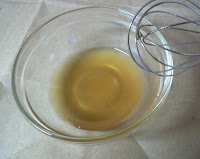 |
| My Oatmeal, Milk, and Honey soap |
Usually I use distilled water for the liquid portion of my recipe, but many liquids can be used instead - beer, wine, tea, milks, fruit or vegetable juices and purees, etc. I substituted the entire water portion of my recipe with fresh goat's milk.
Honestly, I was a bit afraid to try goat's milk soapmaking before now because I had heard that it can be a temperamental process and requires more experience. After 15 months of making cold process soaps, I felt I had enough batches of regular soap under my belt to give goat's milk soap a try.
Making goat's milk soap does require some preparation in advance. Milks contain natural sugars, which can make the lye solution or the soap overheat. Ever curdled milk on your stovetop? Blech. Scorched milk-lye solution turns orange-brown and smells horrid; also, the lye can bubble up and volcano, which is not an ideal situation. Overheated soap can crack, separate into an oily mess, or become a lumpy disaster commonly referred to as "alien brains." To avoid overheating, it is best to freeze the goat's milk, add the lye very slowly, and keep your oils cool.
 |
| Frozen goat's milk |
On soapmaking day, I took the milk out of the freezer and let it sit on the counter to thaw a bit while I set up my work space and got my oils and additives ready.
Because I was going to use an Oatmeal, Milk, and Honey fragrance oil, I decided to add honey and ground oats to my goat's milk soap, too. I bought a coffee grinder just for soapmaking, and I used it to grind up my oats. (The oats were the regular old-fashioned oats - quick-cooking oats can go mushy in soap. I used one Tablespoon of oats per pound of oils.) I dissolved my honey in a bit of warm distilled water to make it more fluid. (I used two teaspoons of honey total for two pounds of oils, mixed with one Tablespoon of warm distilled water.)
 |
| Grinding oats (1 Tbsp oats per pound of oils); ground oats and honey (1 tsp honey per pound of oils) |
 |
| Frozen goat's milk in lye pitcher (l); goat's milk-lye solution (r) |
That's when things got interesting.
During the few minutes I was stirring my oils in the ice bath, my milk-lye solution thickened up to a pudding-like consistency! I am kicking myself now for not taking a picture, but honestly I was so freaked out that all I could think to do was to hurry up and get it into the oils before it set up any further. I quickly added my fragrance oil and honey to my oils and then spooned/scraped my lye solution into the oils. After giving everything a buzz with the stick blender, the soap smoothed out and behaved beautifully, just like a perfect batch. After reaching a medium trace, I stirred my ground oats in with a spatula and then poured my soap into my lined mold.
 |
| Adding ground oats at trace (l); pouring soap into mold (r) |
 |
| Gel phase! See how it's getting hot and gelatinous in the center? |
 |
| Cutting the soap |
The soaps are pretty dark, partly because they gelled and partly because of the fragrance oil, which discolors brown, and the honey.
I can't wait to try this one out! I think this soap will be extra nice with the added honey and oats. And the Oatmeal, Milk, and Honey fragrance is one of my favorites - slightly sweet, warm, and toasty. I still have to wait several weeks for the soap to cure before I can use it. Waiting is the hardest part of soapmaking!
I'm excited to make my own goat's milk soaps since all of the ones I've ever tried have been a real treat. The lather is always so soft, bubbly, and creamy, and it feels great on the skin. One of my favorites was a bar I picked up at a farmer's market that was made with goat's milk AND beer. Talk about great lather! I will definitely have to try that someday in my own soap kitchen.
 Are you a fan of goat's milk soaps? Do you have a favorite goat's milk soap that you enjoy making or using? What is your favorite thing about goat's milk soaps? Any interesting stories or mishaps?
Are you a fan of goat's milk soaps? Do you have a favorite goat's milk soap that you enjoy making or using? What is your favorite thing about goat's milk soaps? Any interesting stories or mishaps?Tell me all the goaty details!






